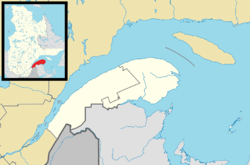New Richmond, Quebec
New Richmond | |
|---|---|
 | |
 Location within Bonaventure RCM. | |
| Coordinates: 48°10′N 65°52′W / 48.167°N 65.867°W[1] | |
| Country | |
| Province | |
| Region | Gaspésie– Îles-de-la-Madeleine |
| RCM | Bonaventure |
| Constituted | July 1, 1855 |
| Government | |
| • Mayor | M Eric Dubé |
| • Federal riding | Gaspésie— Îles-de-la-Madeleine |
| • Prov. riding | Bonaventure |
| Area | |
| • Total | 197.80 km2 (76.37 sq mi) |
| • Land | 168.84 km2 (65.19 sq mi) |
| Population (2011)[3] | |
| • Total | 3,810 |
| • Density | 22.6/km2 (59/sq mi) |
| • Pop 2006-2011 | |
| • Dwellings | 1,746 |
| Time zone | UTC−5 (EST) |
| • Summer (DST) | UTC−4 (EDT) |
| Postal code(s) | |
| Area code(s) | 418 and 581 |
| Highways | |
| Website | www.ville newrichmond.com |
New Richmond is an incorporated municipality in Quebec, Canada, situated on the southern coast of the Gaspé Peninsula between the municipalities of Maria and Caplan.
New Richmond is bounded on the west by the Grand Cascapedia River. The Little Cascapedia runs to the east of the town proper. In addition to New Richmond itself, the town's territory also includes the communities of Black Cape and Saint-Edgar.
History

The first European settlers arrived from Scotland in 1755. The first arrivals were the Duthie brothers, George and John Duthie and their families. Their descendants still reside in the area today. It is one of the very few remaining municipalities on the Gaspé which still has a relatively large English-speaking population. It was originally a centre of farming, logging, and shipbuilding.
Industry
The town experienced considerable growth in the 1960s with the development of a linerboard paper mill by Bathurst paper, which became Consolidated Bathurst and after a number of name changes Smurfit Stone. Economic downturns in the region brought a reduction in mill operations and many residents left for other regions. In 2005 the mill completely shut down, leaving the town with no major industry.
There is a large wharf located to the east of the town. This was built to service cargo ships that would arrive to be loaded with kraft paper or bunker oil. It is now mainly recreational.
The town has a British Heritage Museum. There is a small shopping centre as well as an indoor swimming pool, a hockey arena, and a theatre.
Education
There is an English-language school (New Richmond High School) located in the centre of town which serves now grades K-11. French-speaking children have their own school (Bois Vivant) and complete high school in the town of Carleton.
Demographics
Population
| 2011 | |
|---|---|
| Population | 3,810 (+1.7% from 2006) |
| Land area | 168.84 km2 (65.19 sq mi) |
| Population density | 22.6/km2 (59/sq mi) |
| Median age | 44.4 (M: 43.7, F: 45.0) |
| Private dwellings | 1,746 (total) |
| Median household income | $49,798 |
|
|
|
Language
Mother tongue language (2011)[3]
| Language | Population | Pct (%) |
|---|---|---|
| French only | 3,215 | 84.61% |
| English only | 535 | 14.08% |
| Both English and French | 35 | 0.92% |
| Other languages | 15 | 0.39% |
Notable People from New Richmond
- Paul Willett (Hockey Player)
See also
References
- ^ "Banque de noms de lieux du Québec: Reference number 142202". toponymie.gouv.qc.ca (in French). Commission de toponymie du Québec.
- ^ a b "New Richmond". Répertoire des municipalités (in French). Ministère des Affaires municipales, des Régions et de l'Occupation du territoire. Retrieved 2011-12-29.
- ^ a b c d "2011 Community Profiles". 2011 Canadian census. Statistics Canada. March 21, 2019. Retrieved 2014-01-28.
- ^ "2006 Community Profiles". 2006 Canadian census. Statistics Canada. August 20, 2019.
- ^ "2001 Community Profiles". 2001 Canadian census. Statistics Canada. July 18, 2021.
- ^ Statistics Canada: 1996, 2001, 2006, 2011 census

